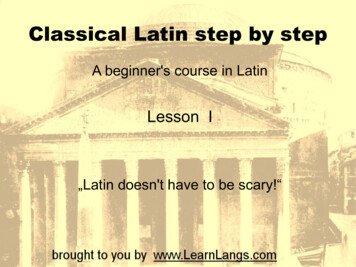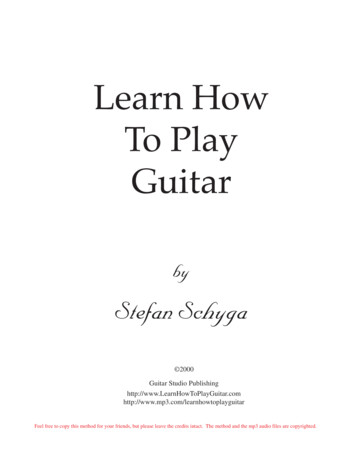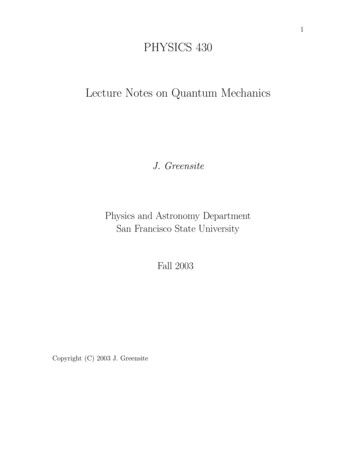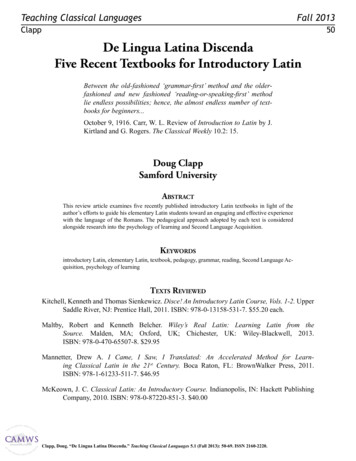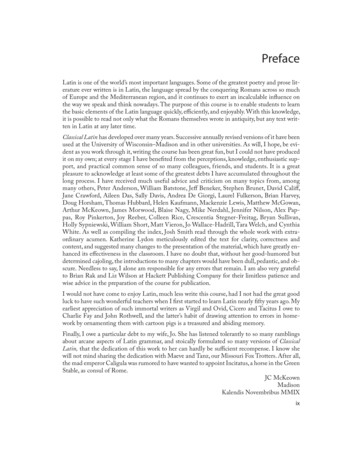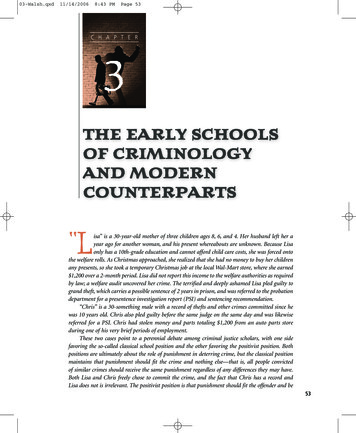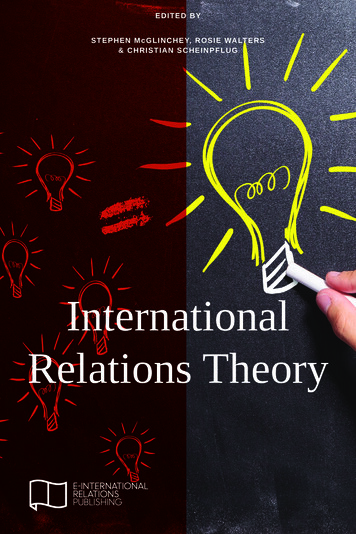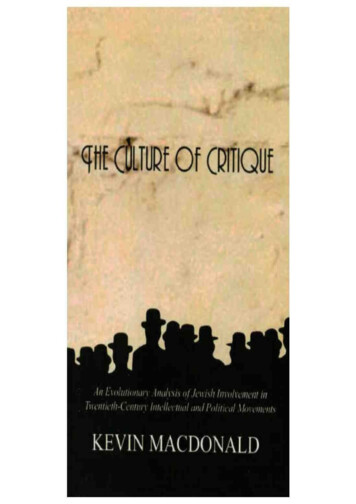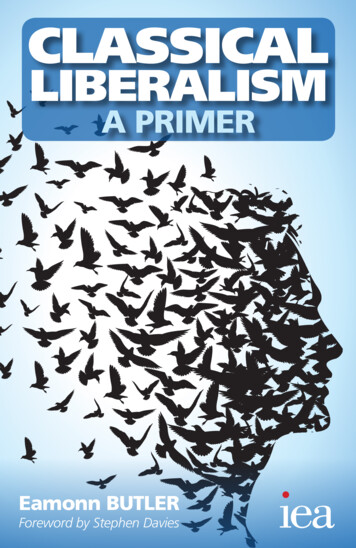
Transcription
CLASSICALLIBERALISMA PRIMEREamonn BUTLERForeword by Stephen Davies
Classical Liberalism – A Primer
CLASSICAL LIBERALISM – A PRIMERE AMONN BUTLER
First published in Great Britain in 2015 byThe Institute of Economic Affairs2 Lord North StreetWestminsterLondon SW1P 3LBin association with London Publishing Partnership Ltdwww.londonpublishingpartnership.co.ukThe mission of the Institute of Economic Affairs is to improve understandingof the fundamental institutions of a free society by analysing and expoundingthe role of markets in solving economic and social problems.Copyright The Institute of Economic Affairs 2015The moral right of the author has been asserted.All rights reserved. Without limiting the rights under copyright reservedabove, no part of this publication may be reproduced, stored or introducedinto a retrieval system, or transmitted, in any form or by any means (electronic, mechanical, photocopying, recording or otherwise), without the priorwritten permission of both the copyright owner and the publisher of this book.A CIP catalogue record for this book is available from the British Library.ISBN 978-0-255-36708-0 (interactive PDF)Many IEA publications are translated into languages otherthan English or are reprinted. Permission to translate or to reprintshould be sought from the Director General at the address above.Typeset in Kepler by T&T Productions Ltdwww.tandtproductions.comPrinted and bound in Great Britain by Page Bros
To my friend John Blundell (1952–2014)
CONTENTSThe author Acknowledgements Foreword Summary 1234xxixiixviiIntroduction 1The purpose of this book Outline of the book 11What is classical liberalism? 3Ten principles of classical liberalism 4Classical liberalism: the family tree 14Early ancestors The rise of classical liberalism Success and reassessment The modern revival of classical liberalism The diversity of classical liberal ideas 1416222427Classical liberalism and freedom 28The arguments for freedom Positive and negative liberty Rights and freedoms Restraints on freedom 28343637vii
C ontents56789viiiClassical liberal morality 38Coercion and toleration The arguments for toleration Toleration and the state 384047Classical liberal politics 50The origin and purpose of government The myth of social justice Public choice and private interests The legitimacy of government 50545661Classical liberal society 62Spontaneous orders Justice and the rule of law The rationality of natural orders Civil society Spontaneous order and natural rights 6265697173Classical liberal economics 74The spontaneous order of the market The spontaneous ‘miracle’ of prices Markets without commands Rules and property The arguments for economic freedom The destabilising effects of government Trade and protectionism 74747677798285Classical liberalism today 86Eclipse and revival The rebirth of classical liberalism The meaning of classical liberalism Classical liberal internationalism The classical liberal vision 8687889194
C ontents10 Key classical liberal thinkers 98John Locke (1632–1704), English philosopher 98Bernard Mandeville (1670–1733), Anglo–Dutch satirist 99Voltaire [François-Marie Arouet] (1694–1778),French writer 99Adam Ferguson (1723–1816), Scottish social theorist 100Adam Smith (1723–1790), Scottish philosopher andeconomist 100Thomas Jefferson (1743–1826), Americanrevolutionary leader 101Frédéric Bastiat (1801–50), French political theorist 101Richard Cobden (1804–1865), English manufacturerand politician 102John Stuart Mill (1806–73), English philosopher andreformer 102Herbert Spencer (1820–1903), English anthropologistand philosopher 103Friedrich A. Hayek (1899–1992), Anglo–Austrianpolitical scientist 104Ayn Rand (1905–82), Russian–American novelist andmoralist 105Isaiah Berlin (1909–97), Latvian–British philosopher 105Milton Friedman (1912–2006), American economist 106James M. Buchanan (1919–2013), American economist 107Robert Nozick (1938–2002), American philosopher 10811 Classical liberal quotations Magna Carta Natural rights Limited government Spontaneous order Benign guidance Versus planning and controls Justice and the rule of law Economic freedom 109109110111112113114115117ix
C ontentsPersonal freedom Political freedom x11812012 Classical liberalism timeline 12213 Further reading 128Introductions Overviews Classic texts Selected web links 128129130131About the IEA 134
THE AUTHOREamonn Butler is director of the Adam Smith Institute, aleading policy think tank. He has degrees in economicsand psychology, a PhD in philosophy, and an honoraryDoctor of Letters. In the 1970s he worked in Washingtonfor the US House of Representatives, and taught philosophy at Hillsdale College, Michigan, before returning to theUK to help found the Adam Smith Institute. He is a formerwinner of the UK’s National Free Enterprise Award.Eamonn is author of books on the pioneering economists Milton Friedman, F. A. Hayek and Ludwig von Mises,a primer on the Austrian School of Economics and TheCondensed Wealth of Nations. For the IEA, he has writtenprimers on Adam Smith, Ludwig von Mises and publicchoice theory; his Foundations of a Free Society won theFisher Prize in 2014. He is co-author of a history of wageand price controls, and of a series of books on IQ. His recentpopular publications, The Best Book on the Market, The Rotten State of Britain and The Alternative Manifesto, attractedconsiderable attention, and he is a frequent contributor toprint and broadcast media.xi
ACKNOWLEDGEMENTSOnce again, I thank Madsen Pirie for his early advice andinput, and my other colleagues at the Adam Smith Institute for their forbearance.xii
FOREWORDClassical liberalism is one of the most important of modernpolitical and social philosophies. Indeed, we may say thatit was the efforts of believers in this set of ideas that werecrucial in bringing the modern world into existence. Without the campaigns, arguments, thinking and analysis ofpeople who defined themselves as classical liberals, manyof the essential features of modernity, such as sustained intensive growth, the privatisation of religious identity andthe abolition of slavery would not have come about.Despite its importance, classical liberalism is todaypoorly understood, often misrepresented (wilfully so inmany cases) and wrongly identified with other ways ofthinking, notably conservatism. A particular difficulty isthe way the American use of the term liberal to mean ‘social democrat’ means that in the English-speaking worldbelievers in traditional liberalism have had to find a newlabel for their ideas. (This is not the case in continentalEurope, where ‘liberal’ retains its traditional meaning.)Libertarian has become the widely adopted term but forvarious reasons this is unsatisfactory.Given this, Eamonn Butler’s account is particularly welcome. It is a wonderfully clear and well set out introduction to what classical liberalism is as a system of thought,xiii
Forewordwhence it came, what it is like now and where it might begoing. One valuable feature of the book is the way that itbrings out the differences and variety within what nevertheless remains a coherent approach to political thinkingand questions of public policy. (The same could be said forsocialism and conservatism of course.) It is worth thinkingabout some of the questions it raises and the ways thesemight be further explored.As the historical account indicates, classical liberalismclearly has roots and origins as a political movement inepisodes of English history and a way of thinking aboutlaw and government that we can trace back to at least theseventeenth century, if not even earlier to Magna Cartaand medieval constitutionalism. However, as it makesclear, there is also a source in the history of continentalEurope, not least in France (despite F. A. Hayek describingthat country as ‘the most hopeless for classic liberalism’).This goes back to the Enlightenment and thinkers such asKant but can also be traced further back, to Renaissanceand late- medieval thinkers such as those associated withthe School of Salamanca, and to the medieval traditionsof constitutional government and limits on royal power,from the Iberian Peninsula to Scandinavia and Poland–Lithuania. Classical liberalism’s origins in Europe do not,however, make it a European way of thinking. It shouldnot be seen as a ‘Western’ ideology; rather it is a perspective that is universal in its orientation and can draw uponcompatible and sympathetic traditions in all the world’scultures and civilisations.xiv
ForewordIn addition to the crucial ideas that this book ably setsout and clearly explains, classical liberalism is also associated with a number of attitudes and qualities of style. Oneof the most important is that of optimism, of confidencethat the human condition can be improved and in the lasttwo centuries has improved. Another related one is that ofbeing forward looking, of looking to the future rather thanat the past. We might also identify a focus on individualityand self-governance or autonomy. Perhaps the most important is that of civility and of thinking the best of one’sopponents and interlocutors rather than ascribing malevolent purposes and designs to them – a quality lacking inmuch contemporary discourse.This work does an excellent job of describing simplyand clearly what classical liberalism is, and also of describing by inference what it is not. Clearly, it is distinctfrom socialism and other forms of egalitarian collectivism such as social democracy and social or ‘new’ liberalism. It is also not the same as conservatism, being generally more optimistic, more trusting in reason (as opposedto faith or tradition), and less respectful of inherited ortraditional institutions. One of the things that becomesapparent on reading this book and which would becomeeven more so on reading much of the suggested furtherreading, is that far from being conservative, classicalliberalism is a radical creed that has already broughtabout an enormous and profound change in the conditions and ways of life of most of the people in the world,sweeping aside much of the old order in doing this (axv
Forewordpoint made forcefully by Ludwig von Mises for example).One example of this is the historical association betweenclassical liberalism and feminism, with most of the ‘firstwave’ feminists ardent classical liberals and with manyexamples of that position to be found today.Classical liberals as a movement and classical liberalism as a body of ideas have changed much and improvedmuch, but there has also been remission, as the bookpoints out, and there is still much to do. When classicalliberals forget this and become rather defenders of the waythings are they lose their impetus and a crucial part of theiridentity. As the work also makes clear with its discussionof new intellectual developments within the tradition, thisis not a fixed and perfected body of ideas with sacred textsand everlasting conclusions that require only glossing andcommentary. Rather it is a vibrant and living intellectualmovement in which the basic insights described hereare constantly reapplied and rethought, with new ideas,analyses and proposals being articulated and the hydra’sheads of error being assaulted.At the IEA we do not explicitly endorse a particularpolitical philosophy, much less the position of a specificpolitical party or movement. Nevertheless, the continuingobjective of understanding social problems and effectivelyaddressing them rules out certain approaches while beingopen to others. Classical liberalism is one of the congenial philosophies and movements that arrives at a way ofthinking and understanding of the world that is compatible and consonant with this, although it is not the only one.xvi
ForewordAs such, this book is a welcome addition to the IEA’s listand will make a major contribution to better understanding of one of the formative philosophies of the modern age.Stephen Dav iesEducation DirectorInstitute of Economic AffairsMay 2015The views expressed in this monograph are, as in all IEApublications, those of the author and not those of the Institute (which has no corporate view), its managing trustees,Academic Advisory Council members or senior staff. Withsome exceptions, such as with the publication of lectures,all IEA monographs are blind peer-reviewed by at leasttwo academics or researchers who are experts in the field.xvii
SUMMARY xviiiClassical liberals give priority to individual freedom insocial, political and economic life. They recognise thatdifferent people’s freedoms may conflict, and disagreeon where the limits to freedom lie, but broadly agreethat individual freedom should be maximised and theuse of force should be minimised.They see the individual as more important thanthe collective and call for limited, representativegovernment that draws its legitimacy from the people.Governments should themselves be bound by the ruleof law, and justice should be dispensed according toaccepted principles and processes.Classical liberals disagree about the exact role ofthe state, but generally wish to limit the use of force,whether by individuals or governments. They call forstates that are small and kept in bounds by knownrules. The main problem of politics is not how tochoose leaders, but how to restrain them once theyhave power.Classical liberalism is not the same as Americanliberalism, which values social freedom but givesmuch economic power to the state. Nor is it anatomistic idea: it sees individuals as members ofvarious overlapping groups, with many family, moral,
S ummary religious or other allegiances. Such civil societyinstitutions are a useful bulwark against central statepower.Free speech and mutual toleration are viewed asessential foundations for peaceful cooperationbetween free people. Classical liberals argue that suchcooperation gives rise to spontaneous social orders(such as markets, customs, culture and language) thatare infinitely more complex, efficient and adaptivethan anything that could be designed centrally.In economics, classical liberals believe that wealthis not created by governments, but by the mutualcooperation of free individuals. Prosperity comesthrough free individuals inventing, creating,saving, investing and, ultimately, exchanging goodsand services voluntarily, for mutual gain – thespontaneous order of the free-market economy.Classical liberalism can be traced back to AngloSaxon England and beyond, but derives largely fromthe ideas of thinkers such as John Locke (1632–1704),Adam Smith (1723–90) and the Founding Fathers of theUnited States. In recent times, it has been refreshed byscholars such as F. A. Hayek (1899–1992) and MiltonFriedman (1912–2006).Different classical liberals advance differentarguments for freedom. Some see it as a good in itself,others appeal to the idea of natural rights enjoyed byall individuals. Some say that authority over othersstems solely from their agreement to submit to laws,embodied in a social contract. A number argue thatxix
S ummary xxsocial and political freedom simply makes everyonebetter off.Classical liberals also advance different argumentsfor toleration. Many believe that forcing people to dothings against their will is costly and damaging andproduces perverse results. Others see no justificationfor interfering in people’s lifestyle choices, providedthat nobody else is harmed by them. Some cite thebenefits of allowing diverse ideas and opinions.Classical liberalism is not a fixed ideology, but aspectrum of views on social, economic and politicalissues, grounded in a belief in freedom and an aversionto the coercion of one individual by another. It hasenjoyed a revival in recent decades, but now facesnew and urgent questions – such as the freedom thatshould be extended to groups who wish to destroyfreedom.
1INTRODUCTIONThe purpose of this bookThis primer aims to provide a straightforward introduction to the principles, personalities and key developmentsin classical liberalism. It is designed for students and layreaders who may understand the general concepts of social, political and economic freedom, but who would like asystematic presentation of its essential elements.The book takes classical liberalism to embrace a widespectrum of views, all of which consider individual freedom and the minimisation of violence as their top priorities, but which may range from something near libertarianism at one end to more conservative views at the other.It sees classical liberals as believing firmly in individualfreedom, but believing that at least some administrationof government and justice is needed to maintain it. Thedebate, among classical liberals at different points on thespectrum, is how large and wide that government roleshould be.Outline of the bookChapter 2 outlines the ten core principles that unite classical liberals, whatever the differences between them.1
C lassical L iberalism – A PrimerChapter 3 then sets out the historical development ofclassical liberalism, from its Anglo-Saxon roots, throughthe Reformation, the Enlightenment and revolutions, to itsnineteenth-century decline and its modern revival today.Chapter 4 considers the arguments for freedom, outlining the different and often conflicting views of classicalliberals from different traditions. Chapter 5 then looks atclassical liberals’ ideas on morality, and the centrality tothem of minimising coercion, either from individuals orthe state. Chapter 6 outlines the thorny debate on whatthe role and limits of that state should be. Chapter 7 explains why classical liberals believe that human societiesare largely self-regulating and create public benefit without needing any large central authority to maintain them.Chapter 8 shows that this is also true in economics, thanksto the evolution of natural institutions such as marketsand prices.Chapter 9 outlines the recent revival in classical liberal thinking, and some of the new schools of thought thathave come up within the classical liberal tradition.The book concludes with sketches of the contributionsof key classical liberal thinkers, some important quotations on classical liberal issues, a timeline of the development of classical liberalism, and further reading.2
2WHAT IS CLASSICAL LIBERALISM?What most defines classical liberals is the priority they giveto individual freedom. Human beings also have other values, of course – honesty, loyalty, security, family and more.But when it comes to our social, political and economic life,classical liberals believe that we should aim to maximisethe freedom that individuals enjoy.Classical liberals maintain that people should be allowed to live their lives as they choose, with only the minimum necessary restraint from other individuals or authorities. They accept that freedom can never be absolute, sinceone person’s freedom may conflict with another’s: we mayall have freedom of movement, but we still cannot all moveonto the same spot at the same time. And freedom doesnot mean you are free to rob, threaten, coerce, attack ormurder others, which would violate their freedom.So what are the limits to individual freedom? Classicalliberalism has no single answer. It is not a dogmatic set ofrules. Classical liberals do not completely agree on wherethe limits to personal (and government) action should lie.But they do broadly agree that any answer should seek tomaximise individual freedom, and that anyone who wantsto curb it must have a very good reason.3
C lassical L iberalism – A PrimerTen principles of classical liberalismTo understand better what classical liberalism is, we canlist ten principles that classical liberals all agree on.1. The presumption of freedomClassical liberals have a presumption in favour of individual freedom or liberty (the words are interchangeablein English). They want to maximise freedom in our political, social and economic life. However, they have differentgrounds for this conclusion.To many, freedom is good in itself. They argue from psychology that, given a choice, people invariably prefer beingfree to being coerced. Others, natural rights advocates, saythat freedom is something given to us by God or Nature.Some argue that freedom is based on a social contract thatpeople in a ‘state of nature’ would have to agree if theywere to avoid chaos and conflict.Many suggest that freedom is an essential requirementfor progress. Some make a humanist point, that freedom isan essential part of what it means to be human: someonewho is controlled by others is not a whole person, but amere cipher. Lastly, utilitarian classical liberals value freedom as the best way to maximise the welfare of society asa whole.2. The primacy of the individualClassical liberals see the individual as more importantthan the collective. They would not sacrifice an individual’s freedom for some collective benefit – at least, not4
W hat is classical liberalism? without some very good justification. They have severaldifferent reasons for this.One view – called methodological individualism – isthat a collective has no existence beyond the individualsthat comprise it. Certainly, society is more than a collection of individuals, just as a house is more than a collectionof bricks. But society has no independent mind of its own;it is individuals who think and value and choose and driveevents. There is no collective ‘public interest’ beyond theinterests of the individuals who comprise that community.And, secondly, those individuals disagree. What is inthe interest of one person may be against the interest ofothers. The reality of sacrificing individual freedom to ‘thecollective’ is that we would be sacrificing it to some particular set of interests, not to everyone’s interests.Another reason is simple experience. History explodeswith examples of the horrors visited on populations whentheir freedom is sacrificed to some leader’s misconceivednotion of the collective good. Even in recent times, one needonly reflect on the atrocities of Hitler, the starvation andpurges under Stalin, or the mass murders ordered by Pol Pot.Fourthly, society is hugely complicated and in constantflux. No single authority could possibly know what is bestfor everyone in this complex, dynamic world. Individualsare far better placed to make decisions for themselves, andshould be left free to do so.3. Minimising coercionClassical liberals want to minimise coercion. They wanta world in which people get along by peaceful agreement,5
C lassical L iberalism – A Primernot one in which anyone uses force or threats to exploit orimpose their will on others.Accordingly, classical liberals give the monopoly on theuse of force to the government and judicial authorities. Butthey want to keep even that to its necessary minimum;they know how easily power can be abused.Classical liberals maintain that any use of force to curbpeople’s actions must be justified. The onus is on anyonewho wants to restrict freedom to show why that is bothnecessary and sufficiently beneficial to warrant it.And more generally, classical liberals hold that individuals should be able to live their lives as they choose, withouthaving to ask anyone’s permission before they do something.There may be a good reason to curb their actions; but it is upto those who want to do so to make the case.4. TolerationClassical liberals believe that the main – or perhaps theonly – good reason to interfere with people’s freedom is toprevent them doing or threatening actual harm to others.They do not believe that we should restrict people’s actionsjust because we disapprove of them or find them offensive.For example, classical liberals defend free speech, evenif some people use this freedom to say things that others– or even everyone else – may think obnoxious. Likewise,individuals should be free to assemble in groups such asclubs, unions or political parties, even if other people findtheir aims and activities repugnant. They should be freeto trade goods and services, even ones (such as drugs andprostitution) of which others might disapprove. And they6
W hat is classical liberalism? should have the freedom to live, to hold whatever opinionsthey please, and practise whatever religion they want.Classical liberals see such toleration as not just good initself. They see toleration and mutual respect as essentialfoundations for peaceful cooperation and the creation ofa beneficial, well-functioning society. Human differencesare a fact of our social life, and always have been. Liberalsdo not believe that those differences can be eliminated,and are deeply sceptical of Utopian attempts to do so.Given that, toleration will always be a necessary part offunctioning social life.5. Limited and representative governmentClassical liberals concede that some force may be neededto prevent people injuring others, and agree that only theauthorities should have this power. Yet they know thatpower is not wielded by some dispassionate ‘state’ but byactual human beings who have the same failings as therest of us. They know that power tends to corrupt, and thatpoliticians often cite the ‘public interest’ for policies thatare actually in their own interests.In addition, social contract theorists such as the English philosopher John Locke (1632–1704) argue that government power comes from individuals, not the other wayround. People give up some of their freedoms to the government in order to maximise their freedom in general. Sogovernment has no legitimate powers beyond the powersthat individuals have themselves; and the whole purpose ofgovernment is to expand freedom, not to restrict it. As theAmerican revolutionary thinker Thomas Paine (1737–1809)7
C lassical L iberalism – A Primerargued, citizens would be within their rights to overthrowany government that broke this trust.But revolution is a last resort. Classical liberals believethat representative and constitutional democracy is thebest means yet discovered for keeping our legislators accountable to the people. Elections are not so much aboutchoosing good leaders, but removing bad ones. The betterinformed and more vigilant the electorate, the better theywork. Even so, democracy has its limits: it may be a goodway to make some decisions, but these are few; usuallywe are better to let individuals make their own choices.6. The rule of lawAnother principle that restrains power and creates greatersecurity for the public is the rule of law. This is the idea thatwe should be governed by known laws, not the arbitrarydecisions of government officials – what the Americanstatesman John Adams (1785–1836) called ‘a governmentof laws, and not of men’.Classical liberals insist that the law should apply equallyto everyone, regardless of gender, race, religion, language,family or any other irrelevant characteristics. It shouldapply to government officers just as much as to ordinarypeople; nobody should be ‘above the law’.To maintain the rule of law requires a system of justice,with independent courts that cannot be manipulated byindividuals or governments. There need to be basic judicialprinciples such as habeas corpus, trial by jury and due process to prevent those in power using the law in their owninterests.8
W hat is classical liberalism? The rule of law has another happy consequence – itmakes life far more predictable, because it enables us toanticipate how people (including officials) will – and willnot – behave. So we can make long-term plans without fearof having them shattered by the caprice of others.7. Spontaneous orderYou may think that a large and complex society needs alarge and powerful government to run it; but classical liberals dispute this. They believe that government is not thebasis of social order. The complex social institutions thatwe see around us are largely unplanned. They are the resultof human action, but not of human design.For example, no central authority or conscious planning was needed to produce language, or our customs andculture, or markets for goods and services. Such institutions simply grow and evolve out of the countless interactions between free people. If, over the centuries, they proveuseful and beneficial, they persist; if not, they change orare abandoned.The Austrian social theorist F. A. Hayek (1899–1992)called the result spontaneous order. Spontaneous orders canbe hugely complex. They evolve through individuals following rules of conduct – like the rules of grammar – that theymight not even realise they are following, and could scarcelydescribe. It is the height of folly, in politicians and officials,to presume that any single mind could comprehend suchcomplex orders, never mind improve on them.9
C lassical L iberalism – A Primer8. Property, trade and marketsClassical liberals believe that wealth is not created by governments, but by the mutual cooperation of individualsin the spontaneous order of the marketplace. Prosperitycomes through free individuals inventing, creating, saving,investing and, ultimately, exchanging goods and servicesvoluntarily, for mutual gain – the spontaneous order of thefree-market economy.This wealth-creating social order grows out of a simplerule: respect for private property and contract, which allows specialisation and trade.Freedom and property are intimately related. The market economy, and the wealth it generates, depends on thefree movement of people, goods, services, capital and ideas.And the existence of private wealth makes it easier forpeople to resist the exploitation of a predatory government.Classical liberals do not allow property to be acquiredby force. In fact, most property is created – crops are raised,houses are built, innovations are developed. Propertyclearly benefits the owner. But, in fact, it benefits everyonebecause it promotes wider
2 What is classical liberalism? 3 Ten principles of classical liberalism 4 3 Classical liberalism: the family tree 14 . a PhD in philosophy, and an honorary Doctor of Letters. . winner of the UK’s National Free Enterprise Award. Eamonn is author of books on the pioneering econo-mists
